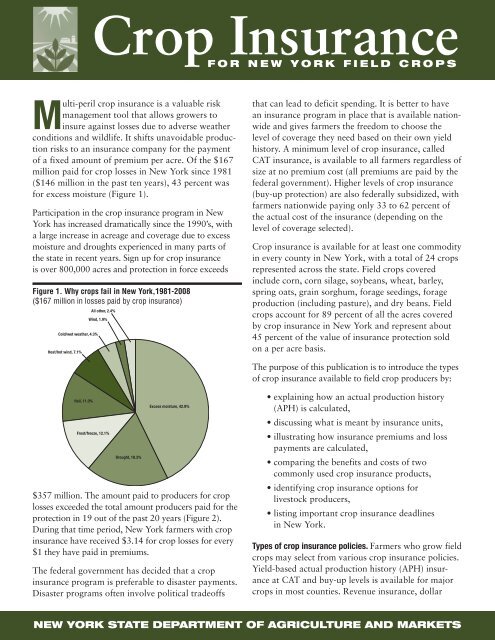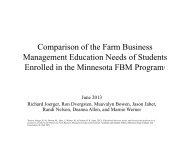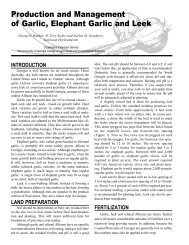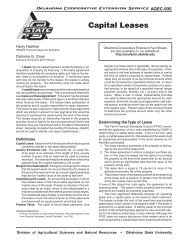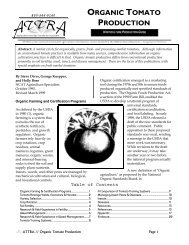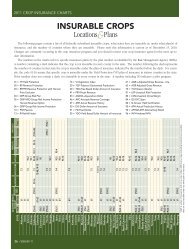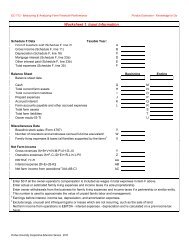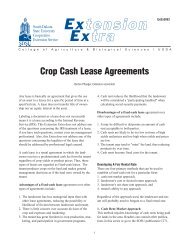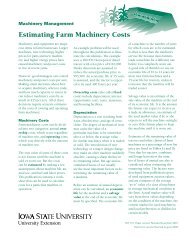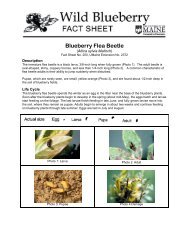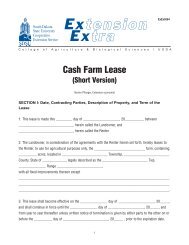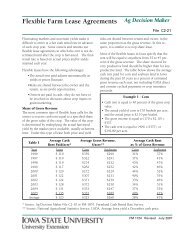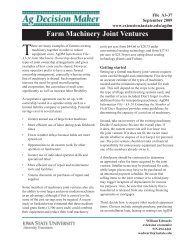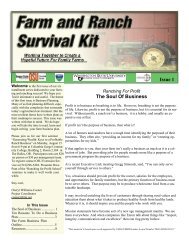Crop Insurance - National Ag Risk Education Library
Crop Insurance - National Ag Risk Education Library
Crop Insurance - National Ag Risk Education Library
Create successful ePaper yourself
Turn your PDF publications into a flip-book with our unique Google optimized e-Paper software.
<strong>Crop</strong> <strong>Insurance</strong><br />
FOR NEW YORK FIELD CROPS<br />
Multi-peril crop insurance is a valuable risk<br />
management tool that allows growers to<br />
insure against losses due to adverse weather<br />
conditions and wildlife. It shifts unavoidable production<br />
risks to an insurance company for the payment<br />
of a fixed amount of premium per acre. Of the $167<br />
million paid for crop losses in New York since 1981<br />
($146 million in the past ten years), 43 percent was<br />
for excess moisture (Figure 1).<br />
Participation in the crop insurance program in New<br />
York has increased dramatically since the 1990’s, with<br />
a large increase in acreage and coverage due to excess<br />
moisture and droughts experienced in many parts of<br />
the state in recent years. Sign up for crop insurance<br />
is over 800,000 acres and protection in force exceeds<br />
Figure 1. Why crops fail in New York,1981-2008<br />
($167 million in losses paid by crop insurance)<br />
Cold/wet weather, 4.3%<br />
Heat/hot wind, 7.1%<br />
All other, 2.4%<br />
Wind, 1.9%<br />
that can lead to deficit spending. It is better to have<br />
an insurance program in place that is available nationwide<br />
and gives farmers the freedom to choose the<br />
level of coverage they need based on their own yield<br />
history. A minimum level of crop insurance, called<br />
CAT insurance, is available to all farmers regardless of<br />
size at no premium cost (all premiums are paid by the<br />
federal government). Higher levels of crop insurance<br />
(buy-up protection) are also federally subsidized, with<br />
farmers nationwide paying only 33 to 62 percent of<br />
the actual cost of the insurance (depending on the<br />
level of coverage selected).<br />
<strong>Crop</strong> insurance is available for at least one commodity<br />
in every county in New York, with a total of 24 crops<br />
represented across the state. Field crops covered<br />
include corn, corn silage, soybeans, wheat, barley,<br />
spring oats, grain sorghum, forage seedings, forage<br />
production (including pasture), and dry beans. Field<br />
crops account for 89 percent of all the acres covered<br />
by crop insurance in New York and represent about<br />
45 percent of the value of insurance protection sold<br />
on a per acre basis.<br />
The purpose of this publication is to introduce the types<br />
of crop insurance available to field crop producers by:<br />
Hail, 11.0%<br />
Frost/freeze, 12.1%<br />
Drought, 18.3%<br />
Excess moisture, 42.9%<br />
$357 million. The amount paid to producers for crop<br />
losses exceeded the total amount producers paid for the<br />
protection in 19 out of the past 20 years (Figure 2).<br />
During that time period, New York farmers with crop<br />
insurance have received $3.14 for crop losses for every<br />
$1 they have paid in premiums.<br />
The federal government has decided that a crop<br />
insurance program is preferable to disaster payments.<br />
Disaster programs often involve political tradeoffs<br />
• explaining how an actual production history<br />
(APH) is calculated,<br />
• discussing what is meant by insurance units,<br />
• illustrating how insurance premiums and loss<br />
payments are calculated,<br />
• comparing the benefits and costs of two<br />
commonly used crop insurance products,<br />
• identifying crop insurance options for<br />
livestock producers,<br />
• listing important crop insurance deadlines<br />
in New York.<br />
Types of crop insurance policies. Farmers who grow field<br />
crops may select from various crop insurance policies.<br />
Yield-based actual production history (APH) insurance<br />
at CAT and buy-up levels is available for major<br />
crops in most counties. Revenue insurance, dollar<br />
NEW YORK STATE DEPARTMENT OF AGRICULTURE AND MARKETS
value, and group risk policies may also be available.<br />
<strong>Insurance</strong> protection is also available on a whole farm<br />
basis as Adjusted Gross Revenue (AGR) insurance in<br />
16 counties and as AGR-Lite in 52 counties. If crop<br />
insurance is not available for a crop in your county,<br />
coverage may still be available via a written agreement;<br />
contact a crop insurance agent for more information<br />
on using written agreements.<br />
Before considering a particular kind of crop insurance<br />
policy, you should first consider how much risk you<br />
are willing to bear and what you need to protect.<br />
Some common objectives are:<br />
1) reducing year-to-year income variability,<br />
2) replacing lost feed,<br />
3) providing a minimum cash flow to<br />
cover input costs,<br />
4) securing adequate credit.<br />
YIELD-BASED INSURANCE COVERAGE:<br />
Actual Production History (APH) insurance protects<br />
producers against losses due to natural causes such as<br />
drought, excessive moisture, hail, wind, frost, insects,<br />
and disease. The APH plan is sometimes referred to as<br />
Multiple Peril <strong>Crop</strong> <strong>Insurance</strong> (MPCI). Farmers select<br />
from 50 to 75 percent of the amount of their average<br />
yield to insure. Farmers can also select between 55<br />
and 100 percent of the crop price established annually<br />
by the United States Department of <strong>Ag</strong>riculture, <strong>Risk</strong><br />
Management <strong>Ag</strong>ency (USDA, RMA). If the harvest is<br />
less than the yield insured, the farmer is paid for the<br />
loss based on the difference. Loss payments are<br />
calculated by multiplying this difference by the<br />
insured percentage of the established price selected<br />
when crop insurance was purchased. APH policies are<br />
available in most New York counties for corn<br />
and oats. APH policies are also available in some<br />
counties for soybeans, forages (containing more<br />
than 25% alfalfa), grain sorghum, barley, wheat,<br />
and dry beans.<br />
Catastrophic crop insurance (CAT) was introduced<br />
in 1995 to replace ad hoc disaster assistance programs<br />
enacted by Congress with an insurance-based<br />
producer safety net that reflects a farmer’s actual<br />
production history. Per acre insurance premiums for<br />
CAT are totally paid by the federal government. For<br />
a flat application fee of $300/crop/county, producers<br />
get a crop insurance yield guarantee of 50 percent of<br />
their farm’s actual production history yield, with any<br />
losses reimbursed at 55 percent of the established crop<br />
price. Compared to higher levels of coverage, CAT<br />
provides only a low level of protection against yield<br />
losses. For some diversified farmers this level of coverage<br />
is enough to protect them against severe cash-flow<br />
shortfalls. Corn farmers who are interested in a<br />
revenue-based insurance program rather than a yieldbased<br />
program can get CAT levels of Indexed Income<br />
Protection.<br />
Group <strong>Risk</strong> Plan (GRP) policies use a county index<br />
as the basis for determining a loss. When the county<br />
yield for the insured crop, as determined by the<br />
Figure 2. Farmer benefits from crop insurance per $1 of premium, New York, 1989-2008<br />
8<br />
7<br />
6<br />
5<br />
4<br />
3<br />
2<br />
1<br />
0<br />
1989<br />
1990<br />
1991<br />
1992<br />
1993<br />
1994<br />
1995<br />
1996<br />
1997<br />
1998<br />
1999<br />
2000<br />
2001<br />
2002<br />
2003<br />
2004<br />
2005<br />
2006<br />
2007<br />
2008<br />
— 2 —
<strong>National</strong> <strong>Ag</strong>ricultural Statistics Service (NASS), falls<br />
below the chosen trigger level, a loss payment is made<br />
to the farmer. Payments are not based on the individual<br />
farmer’s loss records. Yield levels are available for<br />
70 to 90 percent of the expected county yield. GRP<br />
is also available as CAT coverage. GRP protection<br />
involves less paperwork and costs less than farm-level<br />
coverage. However, individual crop losses may not be<br />
covered if the county yield does not suffer a similar<br />
level of loss. Farmers best protected by this type of<br />
insurance are those with crop losses that typically<br />
follow the county pattern. GRP is available for corn<br />
in 30 counties in New York.<br />
A new group risk policy is available on a pilot<br />
program basis for pastures, rangeland, and forage in<br />
15 counties in southern New York. Unlike traditional<br />
yield-based, county level GRP policies, it uses approximate<br />
12 x 12 square mile grids and a rainfall index as<br />
a measure of crop productivity. Producers are insured<br />
based on their location (grid) rather than their county.<br />
The rainfall index policy protects farmers against yield<br />
losses related to lack of precipitation. It is based on<br />
historical NOAA rainfall data and NEXRAD weather<br />
radar system data. Producers must choose at least<br />
two, 2-month time periods to insure under the rainfall<br />
index policy. Because this policy is only available on<br />
a pilot program basis, producers outside these 15<br />
counties can not obtain coverage through a written<br />
HOW CAN I FIND A CROP INSURANCE AGENT?<br />
• Ask your neighbors for their recommendations.<br />
Other farmers are one of the best sources of<br />
information on where to find a knowledgeable<br />
crop insurance agent.<br />
• Check with the insurance agency where you<br />
purchase other types of insurance. Often you<br />
can obtain crop insurance through an agent you<br />
already use for your farm, automobile, liability,<br />
fire, health, or life insurance needs. Many<br />
insurance agencies have agents who specialize<br />
in crop insurance.<br />
• Check with businesses or organizations you use<br />
for farm business management services. Your<br />
banker, cooperative, or a farm organization you<br />
belong to may be able to recommend insurance<br />
agencies who handle crop insurance.<br />
• Use the USDA <strong>Risk</strong> Management <strong>Ag</strong>ency’s web<br />
site (http://www.rma.usda.gov) to locate an<br />
agent in your area. This can be done by clicking<br />
on the “<strong>Ag</strong>ent/Company Locator” under<br />
“Quick Links” on the RMA home page.<br />
agreement with their crop insurance agent. Honey<br />
bees and byproducts may also be insured in every<br />
county in the state under this plan via an apiculture<br />
endorsement.<br />
Dollar Plan (Dollar) coverage provides protection<br />
against declining value due to damage that causes a<br />
yield shortfall. The amount of insurance is based on<br />
the cost of growing a crop in a specific area. A loss<br />
occurs when the annual value of the crop is less than<br />
the amount of insurance. The maximum dollar<br />
amount of insurance is stated on the actuarial document.<br />
Farmers may select a percent of the maximum<br />
dollar amount equal to CAT (catastrophic level of<br />
coverage) or additional coverage levels. The Dollar<br />
plan is available for forage-seeding policies in 8<br />
counties in New York. Many field crop producers may<br />
also be interested to know that Dollar plan<br />
coverage is also available for fresh-market sweet corn<br />
in 54 counties in New York.<br />
REVENUE INSURANCE PLANS:<br />
<strong>Crop</strong> Revenue Coverage (CRC) is an insurance<br />
product for corn, soybean, and wheat that provides<br />
protection against both yield and price risk. Unlike<br />
APH policies that cover only yield losses, CRC<br />
provides revenue protection. The farmer selects a level<br />
of revenue to protect based on price and yield expectations.<br />
Losses are paid if revenues fall below the<br />
guarantee at the higher of an early-season or lateseason<br />
price as determined from futures prices on the<br />
Chicago Board of Trade (CBOT). Late versus early<br />
season prices are covered for up to 100% increases<br />
and unlimited decreases. CRC coverage is available<br />
for corn in 52 counties, soybean in 24 counties, and<br />
wheat in 27 counties. CRC insurance is not available<br />
as CAT coverage.<br />
Indexed Income Protection (IIP) is an insurance product<br />
that is available for corn growers. Losses are paid<br />
if revenues fall below the guarantee because of price<br />
or yield declines from early-season expectations. IIP<br />
coverage is available for corn in 52 counties. CAT<br />
coverage under IIP may offer more benefits than yieldbased<br />
CAT coverage depending on the producer’s<br />
unit structure, average yield, and price election for<br />
the crop year.<br />
Gross Revenue Income Protection (GRIP) is a grouprisk<br />
revenue insurance product based on the GRP<br />
yield program and is available for corn in 30 counties.<br />
— 3 —
For this program, county-level GRP yield information<br />
is converted to revenue using the producer’s choice of<br />
either the price formula for IIP or CRC.<br />
Adjusted Gross Revenue (AGR and AGR-Lite)<br />
insure the revenue of the entire farm rather than an<br />
individual crop by guaranteeing a percentage of average<br />
gross farm revenue. These plans use information<br />
from the past five consecutive years of a producer’s<br />
Schedule F tax forms to calculate the policy revenue<br />
guarantee. Depending on the number of commodities<br />
grown, producers have the choice of three coverage<br />
levels (65, 75, and 80%) and two payment rates<br />
(75 and 90%).<br />
• AGR insurance is currently only available in 16<br />
counties in New York. Besides limited availability,<br />
a major limitation of this product is that only<br />
farms with 35 percent livestock revenue or less are<br />
eligible for coverage. An additional requirement of<br />
AGR coverage is that if crops with individual crop<br />
insurance availability exceed 50 percent of farm<br />
revenues, MPCI coverage is also required (CAT insurance<br />
can be used to meet this requirement). The<br />
maximum policy size for AGR is<br />
$6.5 million (based on maximum adjusted gross<br />
revenues of $13.3 million and the 65% coverage<br />
level and 70% payment rate). The sign-up<br />
deadline for AGR is January 31.<br />
• AGR-Lite represents a major improvement on the<br />
original AGR product, expanding it to provide<br />
protection for all crops and animal revenues (no<br />
limitation on livestock income) and making it<br />
available to farmers in 52 counties statewide.<br />
The application process for AGR-Lite is also<br />
streamlined in various ways and there is no<br />
requirement for the purchase of MPCI (but it<br />
may be purchased at the producer’s option).<br />
The maximum policy size for AGR-Lite is $1<br />
million (based on maximum adjusted gross revenues<br />
of $2,051,282 and the 65% coverage level<br />
and 70% payment rate). The sign-up deadline for<br />
first-time AGR-Lite policy holders is March 15.<br />
Prevented Planting Coverage<br />
Prevented planting coverage provides protection<br />
whenever an eligible crop can not be planted because<br />
of adverse weather conditions, provided it is a condition<br />
general to the geographic area. In New York,<br />
prevented planting coverage is automatically part of<br />
all barley, corn, soybean, grain sorghum, oat, wheat<br />
and dry bean policies (including CAT policies). Basic<br />
prevented planting coverage provides an amount of<br />
protection equal to 60 percent of the insurance<br />
guarantee; higher levels of protection at the 65 and<br />
70 percent level are available for additional premium.<br />
Determining the actual production history<br />
The first step in developing a crop insurance program<br />
is to establish your actual production history (APH).<br />
This is used to set the guarantees under the APH,<br />
CAT, CRC, and IIP plans of insurance. Assessing the<br />
need for production risk protection must be based on<br />
your farm’s production potential and yield variability.<br />
It is a good idea to establish the APH for each insurance<br />
unit with a crop insurance agent long before the<br />
sign-up date. An APH yield is needed even if you are<br />
only interested in the catastrophic (CAT) level of<br />
coverage. It will also allow you to evaluate higher<br />
levels of APH or coverage under revenue insurance<br />
plans (if they are available in your county).<br />
Establishing an APH yield requires a minimum of<br />
four years of records for each crop and land unit to<br />
be insured. Information used to prove crop yields<br />
include sale receipts, farm or commercial storage<br />
records, and feed consumption records. The records<br />
must be for continuous years, starting with the most<br />
recent year and continuing back in time. Once a<br />
missing year is reached, no yield data before that year<br />
may be used. Dropping out a yield from one year<br />
because of poor production is not allowed. It is not<br />
considered a missing year of records if the crop to be<br />
insured was not planted in a certain year. In that case,<br />
a zero acreage report is submitted and continuous<br />
records are maintained even without data for that<br />
year. This is especially important for growers who<br />
rotate crops.<br />
If at least four successive years of records are not<br />
available, a transitional or “T”-yield is substituted for<br />
each missing year. Each insured crop within a county<br />
has an assigned “T”-yield. It is usually based on the<br />
latest available 10-year county average yield. Farmers<br />
with no records at all are assigned 65 percent of the<br />
“T”-yield as their APH yield. Farmers with one year<br />
of records receive 80 percent of the “T”-yield for the<br />
other three years to calculate their APH yield. Farmers<br />
with two years of records receive 90 percent of the<br />
“T”-yield for the other two years. Farmers with three<br />
years of records receive 100 percent of the “T”-yield<br />
for the one remaining year. Once each year has been<br />
assigned a yield, the APH is an average of the four<br />
yields. If only a couple years of yield records exist, the<br />
— 4 —
APH yield may be considerably below the actual expected<br />
yield, because of the reduced “T”-yields. In<br />
that case, buying a GRP or GRIP policy (if available)<br />
is an alternative strategy, since guarantees for these<br />
plans are based on county yields rather than individual<br />
farm yields. This could provide a higher level of<br />
protection while allowing you to accumulate records<br />
to establish an APH yield. However, remember that<br />
GRP and GRIP loss payments are calculated based on<br />
the county average yield and you might not be paid<br />
for an individual loss on your farm.<br />
New farmers or those who have never planted the<br />
crop to be insured receive 100 percent of the “T”-<br />
yield for determining their APH yield. If they continue<br />
to plant the crop for four years, the “T”-yields will be<br />
replaced with the actual production each year. New<br />
producers who have previously been closely associated<br />
with a particular farming operation, such as children<br />
taking over a family farm, can use the previous<br />
operator’s records to establish their APH yield.<br />
When four years of production history are available,<br />
the APH is the average of all of the yearly reported<br />
yields. Additional years of data will be averaged into<br />
the APH yield until 10 years are included. Once<br />
10 years of yields are available, the APH becomes<br />
a moving 10-year average. When a new year of<br />
production history is added, the oldest record is<br />
dropped from the APH calculation.<br />
When a new yield record is added to the APH history,<br />
the APH cannot decrease by more than 10 percent in<br />
any one year. The APH can not fall to less than 70<br />
percent of the “T”-yield for growers with only one year<br />
of yield records, 75 percent for growers with two to four<br />
years of yield records, and 80 percent for growers with<br />
five or more years of yield records. This “floor” prevents<br />
one year with a severe crop failure from having a<br />
disproportionately large influence on the APH yield,<br />
especially when only a few years of yield records are<br />
available. There is also an option to substitute 60<br />
percent of the “T”-yield for actual yields that are less<br />
FEDERAL DISASTER ASSISTANCE PROGRAMS<br />
Noninsured Disaster Assistance Program (NAP)<br />
The Noninsured <strong>Crop</strong> Disaster Assistance Program<br />
(NAP) provides benefits to producers of<br />
commercial agricultural products for which<br />
multi-peril crop insurance coverage is not<br />
available. NAP is designed to reduce financial<br />
losses when natural disasters cause catastrophic<br />
reduction in production. NAP provides coverage<br />
that is very similar to that provided by CAT<br />
policies available through crop insurance agents.<br />
NAP coverage is available through your local<br />
USDA Farm Service <strong>Ag</strong>ency office. To purchase<br />
NAP coverage you pay a fee of $250 per crop<br />
per county (with fees capped at $750 per<br />
producer per county, but not to exceed a total<br />
of $1,875 for producers growing crops in multiple<br />
counties). Sign up deadlines for the NAP<br />
program vary by crop; contact your local FSA<br />
office for more information.<br />
Supplemental Revenue Assistance Payments (SURE)<br />
Many producers do not buy Buy-up or AGR<br />
coverage because they self-insure with other risk<br />
management tools. In the past, many producers<br />
did not buy CAT or NAP coverage because they<br />
felt that if a catastrophic event occurs, the U.S.<br />
government would offer disaster assistance. The<br />
2008 Farm Bill created a permanent disaster<br />
program to replace the “ad hoc” crop disaster<br />
programs (CDP) of past years. This new<br />
program is known as Supplemental Revenue<br />
Assistance Payments (SURE). It is a revenue<br />
based program that uses a formula to compare<br />
the expected revenue to actual revenue for the<br />
entire farming operation.<br />
In order to be eligible for the SURE program,<br />
producers are required to purchase crop insurance<br />
or NAP coverage on all crops that are of<br />
economic significance on the farm. For SURE<br />
program purposes, a “farm” refers to all acreage<br />
in all counties that is planted or intended to be<br />
planted with crops by the producer, including<br />
all hay crops (with the exception of grazed<br />
acreage). Coverage must also be obtained for<br />
other crops for which crop insurance or NAP is<br />
available, including nursery, honey, aquaculture,<br />
and floriculture.<br />
Congress envisioned that if a serious regional<br />
disaster was declared by USDA, then a farmer<br />
would be covered by a combination of crop<br />
insurance and SURE. When a producer buys<br />
higher crop insurance coverage levels, the SURE<br />
guarantee also increases. Unlike crop insurance,<br />
however, payments under SURE should not<br />
be expected until a year or more after the<br />
loss occurs.<br />
— 5 —
than 60 percent of the “T”-yield. There is a slightly<br />
higher premium when this option is selected.<br />
Selecting an insurance unit for crop insurance<br />
You have several options on how you divide your land<br />
to determine APH yields, loss payments, and premiums<br />
under crop insurance. Each parcel of land for<br />
which claims are calculated is called an “insurance<br />
unit.” Unit types include basic, optional, and enterprise<br />
units. One farming operation may have several<br />
insurance units. In this situation, it is possible to have<br />
a crop loss on one unit and receive a loss payment,<br />
while the other units on the same farm produce a<br />
record crop. As a result, many farmers prefer to divide<br />
their land into as many units as possible. You should<br />
check with a crop insurance agent to find out how<br />
many and what type of insurance units your crops<br />
qualify for, and how this could affect your premiums.<br />
You receive one basic unit for the land you own and<br />
cash rent within a county. You also receive one basic<br />
unit for each landlord with whom you crop share<br />
rent. Each crop share landowner can also insure their<br />
own interest in the crop as a separate unit. Each<br />
different crop also creates a separate unit, and tracts<br />
of land in different counties must be insured as<br />
separate units. Each crop/county can have a different<br />
type of policy and level of coverage, and could receive<br />
a loss payment separate from the other units. Separate<br />
production records must be kept for each basic unit.<br />
Insuring all acres as basic units entitles producers to<br />
a 10 percent discount on their premiums.<br />
An enterprise unit combines all of the acres of a single<br />
crop within a county in which you have a financial<br />
interest into a single unit, regardless of whether they<br />
are owned or rented, or how many landlords are<br />
involved. Since the enterprise units are usually larger<br />
than basic units or optional units, it is less likely that<br />
the average yield would be low enough to trigger a<br />
loss payment in a given year. Enterprise units are an<br />
option under CRC and must contain at least 50 acres.<br />
By selecting enterprise units you assume more risk,<br />
but it also reduces CRC premiums by about 50<br />
percent, making it less costly than other insurance<br />
plans. Enterprise units are the only unit structure<br />
available under IIP.<br />
Basic units may be divided into optional units when<br />
a crop is being grown under distinctly different<br />
production practices. For example, a grower with<br />
both irrigated and non-irrigated acres of the same<br />
crop may qualify for optional units. Other special<br />
farming types or practices may also qualify acres to be<br />
insured as separate units. Optional units may also be<br />
established by FSA farm serial number or by section<br />
(one square mile blocks containing 640 acres) in areas<br />
surveyed under the U.S. Rectangular Survey System.<br />
New York is not surveyed into sections; however,<br />
optional units may be established in New York on a<br />
section equivalent basis for annual crops. Optional<br />
units based on section equivalents must be requested<br />
through a crop insurance agent, contain a block of<br />
land at least one mile square, and be clearly indicated<br />
on a map using identifiable boundaries. Separate APH<br />
records must be reported for each optional unit, or the<br />
grower would not receive the 10 percent premium discount<br />
allowed for basic units.<br />
How crop insurance premiums are calculate.<br />
<strong>Crop</strong> insurance premiums depend on your actual<br />
production history (APH yield), the coverage level you<br />
select, the price election you select, and the premium<br />
rate for your county. Based on the level of coverage<br />
and the crop being insured, you pay between 33 and<br />
45 percent of the calculated premium, with the federal<br />
government paying the balance. If you use basic units<br />
rather than optional units, you are eligible for the<br />
additional 10 percent discount.<br />
You can select a coverage level of 50, 55, 60, 65, 70,<br />
or 75 percent of your APH yield. In a sense, this<br />
establishes your “deductible,” similar to the<br />
deductible on your automobile or homeowners<br />
insurance. For example, if a coverage level of 75<br />
percent is selected, then you “self insure” for the first<br />
25 percent of the loss. If the loss was more than 25<br />
percent, crop insurance would cover the difference.<br />
The level of coverage also affects the amount of<br />
protection that is available. Like other insurance, high<br />
levels of deductible have lower premiums, but also<br />
more risk. You also have some choice of the price<br />
election (percentage of the established crop price),<br />
depending on the yield guarantee selected. Selecting<br />
a lower level of price election lowers premiums<br />
slightly. In practice, however, most farmers select<br />
the 100 percent price election.<br />
An important thing to remember about crop insurance<br />
premiums is that they are directly tied to the value<br />
of the crop they are insuring. If commodity prices<br />
increase, then crop insurance protection and<br />
premiums will also increase.<br />
— 6 —
Table 1. Example of the cost of actual production history (APH) insurance for corn grain and gross returns under various yields<br />
(Livingston Co., 150 bu. APH yield, $4.00 indemnity price, $3.50 local cash price).<br />
L evel of crop insurance protection (1)<br />
No<br />
Type of coverage: <strong>Insurance</strong> CAT APH APH APH APH APH APH<br />
Yield guarantee: 0% 50% 50% 55% 60% 65% 70% 75%<br />
Price guarantee: 0% 55% 100% 100% 100% 100% 100% 100%<br />
Producer premium (2): n/a $0.00 $6.80 $8.64 $9.95 $13.04 $15.88 $21.24<br />
Application fee: n/a $300 $30 $30 $30 $30 $30 $30<br />
Actual yield (bu/A)<br />
Gross return minus insurance cost ($/acre)<br />
0 $0 $165 $293 $321 $350 $377 $404 $429<br />
20 $70 $191 $283 $311 $340 $367 $394 $419<br />
40 $140 $217 $273 $301 $330 $357 $384 $409<br />
60 $210 $243 $263 $291 $320 $347 $374 $399<br />
80 $280 $280 $273 $281 $310 $337 $364 $389<br />
100 $350 $350 $343 $341 $340 $337 $354 $379<br />
120 $420 $420 $413 $411 $410 $407 $404 $399<br />
140 $490 $490 $483 $481 $480 $477 $474 $469<br />
160 $560 $560 $553 $551 $550 $547 $544 $539<br />
180 $630 $630 $623 $621 $620 $617 $614 $609<br />
200 $700 $700 $693 $691 $690 $687 $684 $67<br />
Yield guarantee:<br />
__________<br />
0 75 75 82.5 90 97.5 105 112.5<br />
Notes:<br />
1. CAT: catastrophic crop insurance (APH); available at no premium cost to the producer (flat application fee of $300/crop/county).APH: higher levels of APH insurance (“buy-up protection”) available for<br />
additional premium ($30/crop application fee).<br />
2. Producer premium takes into account only federal premium subsidies. Optional units are used for premium calculation. Selecting basic units would reduce premiums by 10%.<br />
Comparing crop insurance alternatives for field crops<br />
To demonstrate the different types of crop insurance coverage<br />
available to a field crop producer, a corn farmer<br />
with a 150-bushel APH yield in Livingston County will be<br />
used as an example. Gross returns for various levels of<br />
MPCI coverage (CAT and buy up levels of protection)<br />
versus having no insurance are compared in Table 1.<br />
By comparing the various options you can see how farm<br />
cash flow is protected by using MPCI. In this example,<br />
CAT would pay the farmer $165/A for a total crop loss.<br />
Buy-up coverage provides even more cash-flow protection<br />
for this farmer. A minimum cash flow of $293 to<br />
$429/A is guaranteed in exchange for a producer-paid<br />
premium of $6.80 to $21.24/A. As the level of crop insurance<br />
protection goes up, the grower is guaranteed a<br />
less-variable cash flow. The only advantage of having no<br />
crop insurance is saving the premium cost. Elimination<br />
of this cost would have a minor positive impact on cash<br />
flow during good years and a potentially disastrous<br />
impact on cash flow in a poor year.<br />
This farmer also has the option of using a revenuebased<br />
insurance coverage like CRC or IIP. CRC and<br />
IIP are both products that use futures prices to set the<br />
value of the crop and pay for revenue losses (because<br />
of yield losses or price declines) rather than only yield<br />
losses as under APH. Gross returns for various levels<br />
— 7 —<br />
of CRC coverage versus having no insurance are<br />
compared in Table 2.<br />
Under a CRC policy a minimum cash flow of $293 to<br />
$418/A is guaranteed in exchange for a farmer-paid<br />
premium of $10.20 to $36.48/A. As the level of CRC<br />
protection goes up, the farmer is guaranteed less-variable<br />
cash flows for any potential revenue combination<br />
when compared to either having no insurance or yield<br />
triggered APH coverage. In years when the harvest time<br />
CRC price is less than the early price (set from futures<br />
prices in February), the effective loss payment trigger<br />
point will be higher than the selected level of coverage<br />
(example: early price $4.04/$3.75 harvest time price<br />
x 75 percent level = 81 percent loss trigger point<br />
(effective level of coverage)).<br />
The only advantage of having no crop insurance is saving<br />
the premium cost. Elimination of this cost would<br />
have a minor positive impact on cash flow during good<br />
years and a potentially disastrous impact on cash flow in<br />
a poor year. Choosing a level of coverage is a personal<br />
business decision. Not everyone feels the same about<br />
production risk and everyone has different financial<br />
resources. One way to choose would be to determine<br />
how much cash-flow protection you need and pick a<br />
coverage level and price election combination that<br />
accomplishes your goal.
Table 2. Example of the cost of crop revenue coverage (CRC) insurance for corn grain and gross returns under various yields<br />
(Livingston Co., 150 bu. APH yield, $4.04 early Chicago Board of Trade price, $3.50 local cash price).<br />
L evel of crop insurance protection (1)<br />
No<br />
<strong>Insurance</strong> CRC CRC CRC CRC CRC CRC<br />
Coverage level: 0% 50% 55% 60% 65% 70% 75%<br />
Producer premium (2): n/a $10.20 $13.31 $15.76 $21.22 $26.56 $36.48<br />
Application fee: n/a $30 $30 $30 $30 $30 $30<br />
Actual yield (bu/A)<br />
Gross return minus insurance cost ($/acre)<br />
0 $0 $293 $320 $348 $373 $398 $418<br />
20 $70 $282 $309 $337 $362 $387 $407<br />
40 $140 $271 $298 $326 $351 $376 $396<br />
60 $210 $260 $288 $315 $340 $365 $386<br />
80 $280 $270 $277 $305 $329 $354 $375<br />
100 $350 $340 $337 $334 $329 $344 $364<br />
120 $420 $410 $407 $404 $399 $393 $384<br />
140 $490 $480 $477 $474 $469 $463 $454<br />
160 $560 $550 $547 $544 $539 $533 $524<br />
180 $630 $620 $617 $614 $609 $603 $594<br />
200 $700 $690 $687 $684 $679 $673 $664<br />
Revenue guarantee: $0 $303 $333 $364 $394 $424 $455<br />
__________<br />
Notes:<br />
1. CRC: crop revenue coverage ($30/crop application fee).<br />
2. Producer premium takes into account only federal premium subsidies. Optional units are used for premium calculation. Selecting basic units would reduce premiums by 10%.<br />
Selecting enterprise units would reduce premiums by about 50%.<br />
<strong>Crop</strong> insurance for livestock producers<br />
<strong>Crop</strong> insurance products have also been developed for<br />
farmers who produce forages for on-farm use. Policies<br />
are available in 52 counties for corn silage and in 8<br />
counties for forage production and forage seeding.<br />
Coverage for corn silage and forage production (alfalfa<br />
and alfalfa mixtures) is available as APH insurance.<br />
Forage seeding (containing at least 50 percent approved<br />
legumes) is insured under the Dollar plan.<br />
Corn silage and forage producers who want APH<br />
coverage will need to develop an APH yield and keep<br />
accurate farm management records on total acres and<br />
production. Because of the numerous ways forages can<br />
be harvested and stored, and depending on when they<br />
are fed, field visits by a representative of your crop insurance<br />
company are often required to verify production.<br />
Field visits are required if production cannot be<br />
measured after harvest (i.e., storage of high-moisture<br />
corn or silage in airtight storage structures). Records<br />
that can help establish APH yields for forages include<br />
acreage data, field harvest records, livestock feeding<br />
records (including grazing data), silo measurements, inventory<br />
records, and sales receipts. If you suspect that<br />
you have a crop loss, notify your crop insurance agent<br />
immediately. A loss adjuster must assess damage before<br />
harvest or you must obtain advance permission from<br />
your crop insurance agent to leave representative<br />
samples of the unharvested crop for inspection. This<br />
sample must be at least 10 feet wide and extend the<br />
entire length of each field in the insurance unit.<br />
Corn silage crop insurance is available in the 52 New<br />
York counties with corn grain policies. Because livestock<br />
producers usually harvest both silage and grain, there is<br />
some flexibility in the program to allow for changes in<br />
harvest method. On the acreage-reporting date you must<br />
indicate which acreage you choose to insure as silage<br />
and which acreage you choose to insure as grain. The<br />
insurance provider must be notified before you harvest<br />
any acreage in a manner other than as originally reported<br />
for coverage (for example, it was reported as<br />
grain, but will be harvested for silage, or it was reported<br />
as silage, but will harvested for grain). If there is a production<br />
loss, appraisals will be made according to how<br />
you reported the acreage for coverage (grain or silage).<br />
Although 17 counties have crop insurance for grain<br />
sorghum, only those hybrids planted for harvest as grain<br />
are covered. Dual-purpose varieties that can be harvested<br />
for either grain or silage are not insurable.<br />
APH-based forage crop insurance policies are available<br />
in only 8 counties and only for alfalfa and alfalfa mixtures.<br />
Premiums are based on the amount of alfalfa in<br />
— 8 —
the field. One set of rates applies to pure stands of<br />
alfalfa or a stand of alfalfa and grass in which 60 percent<br />
or more of ground cover is alfalfa, while the other<br />
applies to mixed stands of alfalfa and grass in which<br />
alfalfa makes up more than 25 percent but less than 60<br />
percent of the ground cover. Stands with less than 25<br />
percent alfalfa are not insurable. Forage production<br />
policies have a minimum requirement for an adequate<br />
stand based on the number of living plants per square<br />
foot after the year of establishment. For pure alfalfa<br />
stands an adequate stand is 9.0 alfalfa plants per square<br />
foot the first year; 6.0 plants the second year; and 4.5<br />
plants the third and later years. For an alfalfa/grass<br />
mixture an adequate stand is defined as 6.0 alfalfa<br />
plants per square foot the first year; 4.0 plants the<br />
second year; and 3.0 the third and later years.<br />
If you live in southern New York, the new pasture,<br />
rangeland, and forage (PRF) rainfall index group-risk<br />
policy may be a good choice for insuring your hay crops<br />
and pastures. Advantages of these policies include flexibility<br />
of when to insure during the year and how much<br />
to insure (producers are not required to insure all their<br />
acreage). They also allow the farmer to adjust coverage<br />
to better match the value of the crop and the productive<br />
capacity of the land.<br />
Forage seeding policies are available in 8 counties and<br />
provide a dollar amount of insurance. Forage seeding<br />
policies are available for both fall-seeded and springseeded<br />
fields. To be insurable, at least 50 percent of the<br />
seed mixture use must be alfalfa, clover, Birdsfoot trefoil<br />
(or any locally recognized and approved legume species)<br />
by weight. Another restriction is that acreage covered by<br />
a forage seeding policy can not be grazed during the insurance<br />
period.<br />
There is a new product available in every county in New<br />
York to help dairy producers manage their market risk.<br />
The livestock gross margin (LGM) for dairy product is<br />
designed to protect producers from unexpected declines<br />
in the market value of their milk minus feed costs. It<br />
uses adjusted futures prices to determine the difference<br />
between expected gross margin and the actual gross<br />
margin. Producers can purchase LGM dairy insurance<br />
monthly and have the option to buy protection for from<br />
1 to 11 months.<br />
Some important crop insurance equations:<br />
APH Plan yield guarantees and premiums:<br />
-Yield guarantee = APH yield x coverage level<br />
-Total premium/acre = Yield guarantee x price<br />
election x county premium rate<br />
-Subsidy amount = Total premium/acre x subsidy<br />
factor<br />
-Producer premium/acre = Total premium/acre –<br />
subsidy amount<br />
APH Plan Loss payments:<br />
-If actual yield is less than the yield guarantee:<br />
-Loss payment = (yield guarantee – actual<br />
production) x price election<br />
-If actual yield is equal to or greater than the<br />
yield guarantee:<br />
-Loss payment = 0<br />
CRC Plan revenue guarantees and premiums:<br />
-Revenue guarantee = APH yield x coverage level<br />
x early CBOT price<br />
-Total premium/acre = Revenue guarantee<br />
x county premium rate<br />
-Subsidy amount = Total premium/acre x subsidy<br />
factor<br />
-Producer premium/acre = Total premium/acre –<br />
subsidy amount<br />
CRC Loss payments:<br />
-If the late CBOT price is greater than the early<br />
CBOT price, the revenue is recalculated<br />
(no additional premium):<br />
-Revenue guarantee = APH yield x coverage level<br />
x late CBOT price<br />
-If actual yield is less than the yield guarantee:<br />
-Loss payment = Revenue guarantee – actual<br />
revenue<br />
-If actual revenue is equal to or greater than the<br />
revenue guarantee:<br />
-Loss payment = 0<br />
Dollar plan amount of coverage and premiums:<br />
-Dollar guarantee = County maximum amount<br />
of coverage x coverage level<br />
-Total premium/acre = Dollar guarantee x county<br />
premium rate<br />
-Subsidy amount = Total premium/acre x subsidy<br />
factor<br />
-Producer premium/acre = Total premium/acre –<br />
subsidy amount<br />
Dollar Plan Loss payments:<br />
-If the value of production to count is less than<br />
the Dollar guarantee:<br />
-Loss payment = Dollar guarantee – value of<br />
production to count<br />
-If the value of production to count is greater than<br />
or equal to the Dollar guarantee:<br />
-Loss payment = 0<br />
— 9 —
IMPORTANT CROP INSURANCE DATES<br />
Deadlines for sales closing, final planting date, acreage reporting, billing, and contract changes for New York crop<br />
insurance products are listed in Table 3. As a crop insurance user you should be aware of several important dates for<br />
filing information and reporting losses:<br />
• Enrollment and policy change date (sales closing date)—last day to apply for coverage or make changes to the<br />
policy; the sign up deadline.<br />
• Final planting date—last day to plant with full coverage. Late planting may be insurable at reduced coverage for some crops.<br />
• Acreage reporting date—last day to report the acreage planted. If not reported, insurance may not be in effect.<br />
• Date to file notice of crop damage—within 72 hours of initial discovery of damage (but not later than 15 days after<br />
the end of the insurance period for each insurance unit). There may be additional requirements by crop. An adjuster<br />
must have the opportunity to inspect the crop before it is destroyed or put to another use.<br />
• End of insurance period—date when crop insurance coverage ceases for the crop year.<br />
• Payment due date—last day to pay the premium without being charged interest.<br />
• Cancellation date—last day to request cancellation of policy for the next year (same date as sales closing date).<br />
• Production reporting date—last day to report production for Actual Production History (APH).<br />
• Debt termination date—date insurance company will terminate policy for nonpayment.<br />
• Billing date—date crop insurance premiums are due. <strong>Crop</strong> insurance premiums not due until after the cropping<br />
season is over and any losses have been paid.<br />
• End of insurance period—the date when your crop insurance coverage ends. Any notices of crop damage must<br />
be filed within 15 days of the end of the insurance period.<br />
Table 3. Important deadlines for crop insurance in New York.<br />
Type of insurance* Enrollment and policy change Final planting Acreage reporting Billing date End of insurance period<br />
AGR whole farm revenue 1/31 -- -- 12/1 --<br />
AGR-Lite whole farm revenue 3/15 (first time) -- -- 12/1 --<br />
1/31 (renewals)<br />
Apiculture GRP 11/30 -- 11/30 10/1<br />
Apples APH 11/20 -- 1/31 9/15 11/5<br />
Barley (winter) APH 9/30 9/30 11/15 10/1 10/31<br />
Cabbage APH 3/15 5/31 6/5 10/1 11/25<br />
Corn APH 3/15 6/10 7/15 10/1 9/30***<br />
Corn CRC, IIP 3/15 6/10 7/15 10/1 12/10<br />
Corn GRP, GRIP 3/15 -- 7/15 10/1 --<br />
Dairy LGM monthly -- -- at sign up --<br />
Dry Beans APH 3/15 6/30 7/15 10/1 10/31<br />
Forage Production APH 9/30 -- 11/15 7/1 10/15<br />
Forage Seeding (fall) DO 7/31 8/31 9/15 7/1 10/15***<br />
Grain Sorghum APH 3/15 6/20 7/15 10/1 12/10<br />
Grapes APH 11/20 -- 1/31 9/15 11/20<br />
Green Peas APH 3/15 5/20 7/15 10/1 9/15<br />
Nursery (field DO 5/1** -- -- 3/1 5/31<br />
grown and container)<br />
Oats (spring) APH 3/15 5/10 6/15 10/1 10/31<br />
Onions APH 2/1 5/10 6/15 10/1 10/15<br />
Pasture and Hayland 11/30 -- 11/30 7/1 --<br />
Rainfall Index<br />
Peaches APH 11/20 -- 1/31 9/15 9/30<br />
Potatoes APH 3/15 5/30 or 6/10 7/15 10/1 10/31<br />
Processing Beans APH 3/15 7/25 7/31 10/1 9/30<br />
Soybeans APH, CRC 3/15 6/10 7/15 10/1 12/10<br />
Sweet Corn (fresh-market) DO 3/15 6/20 or 6/30 7/15 10/1 9/15 or 9/30<br />
Sweet Corn (processing) APH 3/15 6/20 or 6/30 7/15 10/1 9/20<br />
Tomatoes APH 3/15 6/5 7/15 10/1 10/10<br />
Wheat APH, CRC 9/30 10/10 11/15 10/1 10/31<br />
* APH—actual production history insurance, with loss payment based on deviation from APH yield. Premiums vary with APH yield.<br />
CRC—crop revenue coverage, loss payment based on lower than expected gross revenue.<br />
IIP—indexed income protection, loss payment based on lower than expected gross revenue.<br />
DO—dollar plan, loss payment based on value of the crop relative to the dollar amount of insurance.<br />
GRP—group risk plan. For corn and forage production, loss payments are based on relative county yield level and grower selected yield trigger.<br />
For Apiculture and PRF policies, loss payments are based on an index of vegetative greenness and a grower selected coverage level, productivity<br />
factor trigger, and choices of when insurance protection is in force.<br />
LGM—livestock gross margin, loss payments based on difference between expected gross margin and the actual gross margin.<br />
** For nursery crops the policy change date is 5/1, but insurance can be obtained at any time. <strong>Insurance</strong> attaches 30 days after enrollment.<br />
***Multiple dates exist for this crop depending on the county. The earliest end of insurance period date is shown in the table.<br />
— 10 —
<strong>Crop</strong> <strong>Insurance</strong> availability in New York, by county.<br />
County<br />
Adj. Gross Revenue (AGR)<br />
Adj. Gross Revenue-Lite (AGR-L)<br />
Apiculture (GRP)<br />
Apples (APH)<br />
Barley (APH)<br />
Cabbage (APH)<br />
Dry Beans (APH)<br />
Corn (APH, CRC, IIP)<br />
Corn (GRIP, GRP)<br />
Dairy (LGM)<br />
Forage Production (APH)<br />
Forage Seeding (DO)<br />
Grain Sorghum (APH)<br />
Grapes (APH)<br />
Green Peas (APH)<br />
Nursery (FG&C) (DO)<br />
Oats (APH)<br />
Onions (APH)<br />
Pasture, Rangeland, Forage (GRP)<br />
Peaches (APH)<br />
Potatoes (APH)<br />
Processing Beans (APH)<br />
Soybeans (APH, CRC)<br />
Sweet Corn, fresh-market (DO)<br />
Sweet Corn, processing (APH)<br />
Tomatoes (APH)<br />
Wheat (APH, CRC)<br />
Albany X X X X X X X<br />
Allegany X X X X X X X X X X X X X<br />
Bronx X X X<br />
Broome X X X X X X X X X X<br />
Cattaraugus X X X X X X X X X X X X X X X X<br />
Cayuga X X X X X X X X X X X X X X X X X X X<br />
Chautauqua X X X X X X X X X X X X X X X X<br />
Chemung X X X X X X X X X X<br />
Chenango X X X X X X X X<br />
Clinton X X X X X X X X<br />
Columbia X X X X X X X X X X X<br />
Cortland X X X X X X X X X X X<br />
Delaware X X X X X X X X<br />
Dutchess X X X X X X X X X X<br />
Erie X X X X X X X X X X X X X X X X<br />
Essex X X X X X X X X<br />
Franklin X X X X X X X X<br />
Fulton X X X X X X X X<br />
Genesee X X X X X X X X X X X X X X X X X X X X<br />
Greene X X X X X X X<br />
Hamilton X X X<br />
Herkimer X X X X X X X X X X<br />
Jefferson X X X X X X X X X X X X X X X<br />
Kings X X X<br />
Lewis X X X X X X X<br />
Livingston X X X X X X X X X X X X X X X X X X<br />
Madison X X X X X X X X X X X X X X<br />
Monroe X X X X X X X X X X X X X X X X X X<br />
Montgomery X X X X X X X X X X X<br />
Nassau X X X<br />
New York X X X<br />
Niagara X X X X X X X X X X X X X X X X X X<br />
Oneida X X X X X X X X X X X X X X<br />
Onondaga X X X X X X X X X X X X X<br />
Ontario X X X X X X X X X X X X X X X X X X X X X X X<br />
Orange X X X X X X X X X X X X<br />
Orleans X X X X X X X X X X X X X X X X X X X X X<br />
Oswego X X X X X X X X X X X X X<br />
Otsego X X X X X X X X X X<br />
Putnam X X X<br />
Queens X X X<br />
Rensselaer X X X X X X X X X X<br />
Richmond X X X<br />
Rockland X X X X X X<br />
St. Lawrence X X X X X X X X X X<br />
Saratoga X X X X X X X X X<br />
Schenectady X X X X X X<br />
Schoharie X X X X X X X X X X<br />
Schuyler X X X X X X X X X X X X X X X X<br />
Seneca X X X X X X X X X X X X X X X X X X<br />
Steuben X X X X X X X X X X X X X X X X X X X<br />
Suffolk X X X X X X X X X X X X<br />
Sullivan X X X X X X X<br />
Tioga X X X X X X X X X<br />
Tompkins X X X X X X X X X X X X X X<br />
Ulster X X X X X X X X X X X X<br />
Warren X X X X X X<br />
Washington X X X X X X X X X X X<br />
Wayne X X X X X X X X X X X X X X X X X X X<br />
Westchester X X X X<br />
Wyoming X X X X X X X X X X X X X X X X<br />
Yates X X X X X X X X X X X X X X X X X X<br />
Total counties 16 52 62 25 15 3 13 52 30 62 8 8 17 11 17 62 46 12 15 6 15 18 24 54 11 6 27<br />
— 11 —
New York State Department<br />
of <strong>Ag</strong>riculture & Markets<br />
10B Airline Drive<br />
Albany, NY 12235<br />
NYS Department of<br />
<strong>Ag</strong>riculture and Markets<br />
10B Airline Drive<br />
Albany, NY 12235<br />
800-554-4501<br />
http://www.agmkt.state.ny.us/AP/<strong>Crop</strong><strong>Insurance</strong>.html<br />
More information on crop insurance and agricultural<br />
risk management can be found on the Internet:<br />
New York State Department of<br />
<strong>Ag</strong>riculture and Markets<br />
http://www.agmkt.state.ny.us/<br />
United States Department of<br />
<strong>Ag</strong>riculture, <strong>Risk</strong> Management <strong>Ag</strong>ency<br />
http://www.rma.usda.gov<br />
<strong>National</strong> <strong>Ag</strong> <strong>Risk</strong> <strong>Education</strong> <strong>Library</strong><br />
http://www.agrisk.umn.edu<br />
Northeast Center for<br />
<strong>Risk</strong> Management <strong>Education</strong><br />
http://www.necrme.org<br />
<strong>Risk</strong> Management <strong>Ag</strong>ency,<br />
US Department of <strong>Ag</strong>riculture<br />
http://www.rma.usda.gov<br />
This publication is for educational purposes only and does not<br />
cover all aspects of the crop insurance products described.<br />
For specific information about crop insurance products and how<br />
they could help you manage risk on your operation, visit your<br />
local crop insurance agent.<br />
__________<br />
Prepared by:<br />
Jayson K. Harper<br />
Professor of <strong>Ag</strong>ricultural Economics<br />
Department of <strong>Ag</strong>ricultural Economics and Rural Sociology<br />
The Pennsylvania State University for the<br />
New York State Department of <strong>Ag</strong>riculture and Markets<br />
in conjunction with the USDA <strong>Risk</strong> Management <strong>Ag</strong>ency


